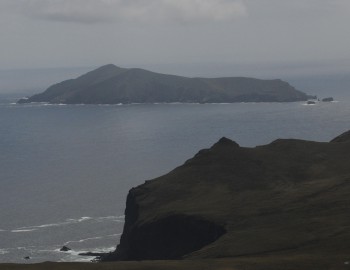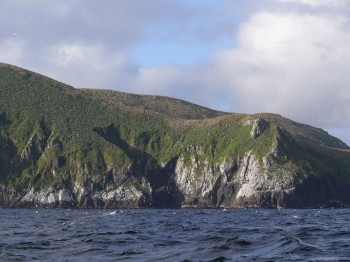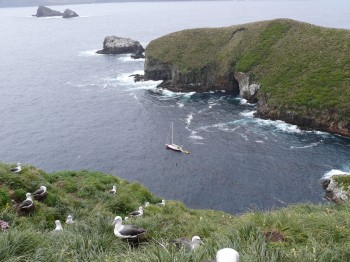Disappointment Island forms part of New Zealand’s Auckland Islands National Nature Reserve. It is one of a number of islands of various sizes that surround the main island of Auckland, along with Adams, Enderby and several others.



Three views of Disappointment Island, from the air and from the main island
Photographs by Barry Baker
It lies some eight kilometres off the north-west end of the 510-km² main island. Disappointment Island is 4 km long by up to 1 km wide with a stated area of 566 ha (also cited as 392 ha); it rises steeply from the sea to a plateau, with its highest point at 318 m. It is covered in Poa litorosa tussock grassland and flowering megaherbs such as the Campbell Island Daisy Pleurophyllum speciosum, Ross Lily Bulbinella rossii and Macquarie Island Cabbage Stilbocarpa polaris, with scattered areas of Hebe elliptica shrubland and fellfield around the island’s top.

Disappointment's steep slopes...
Photograph by Pete McClelland

...and its cliff-girt shoreline
Photograph by Paul Sagar
The island group is surrounded by a recently declared large marine reserve: the Auckland Islands/Motu Maha Marine Reserve that covers an area of c. 484 000 ha (click here). Disappointment Island falls within the New Zealand Sub-Antarctic Islands World Heritage Site inscribed in 1998 which includes five island groups (Antipodes Islands, Auckland Islands, Bounty Islands, Campbell Island and the Snares Islands). The island is also part of the proposed Auckland Islands Important Bird Area (IBA).
Gibson’s Antipodean Diomedea antipodensis gibsoni, White-capped Thalassarche steadi and Light-mantled Sooty Phoebetria palpebrata Albatrosses breed on Disappointment. Gibson’s Antipodean Albatrosses breed on the plateau, whereas the other two albatross species breed on the island’s slopes and cliffs. The first species had populations of 250 annually breeding pairs present in 1993 and 352 pairs in 1997. A count is currently being made from aerial photographs of the plateau taken this last austral summer so an up-to-date census will become available soon.

White-capped Albatrosses breeding on sloping ground among the Silver-leaf Daisy Pleurophyllum hookeri and Poa litorosa tussock
Photograph by Paul Sagar
In January 2013 counts made from aerial photographs estimated the annual breeding population of the Near Threatened White-capped Albatross on Disappointment as 111 312 pairs, which represents c. 95% of the species’ total population. When compared to aerial counts made in the previous half decade the population appears to be stable. About 30 Light-mantled Sooty Albatross occupied nests were counted on aerial photographs taken in January 2014.
Two other ACAP-listed species are known to breed on the island: Northern Giant Petrel Macronectes halli and White-chinned Petrel Procellaria aequinoctialis. Population estimates and trends appear lacking for them (click here).

White-capped Albatrosses in the air above their breeding colony on Disappointment
Photograph by Paul Sagar

The yacht Tiama shelters below breeding White-capped Albatrosses in 2008
Photograph by Paul Sagar
Disappointment Island has a tragic history as its name suggests. Two shipwrecks on the island or close by over a century ago led to the loss of life and parties being marooned in the island group for up to 18 months. Unlike the main Auckland Island, Disappointment has remained free of introduced rodents and other mammals – and seemingly alien plants - despite the shipwrecks.
With thanks to Barry Baker, Pete McClelland and Paul Sagar for information and photographs.
Selected Literature:
Baker, G.B., Double, M.C., Gales, R., Tuck, G.N., Abbott, C.,L., Ryan, P.G., Petersen, S.L., Robertson, C.J R. & Alderman, R. 2007. A global assessment of the impact of fisheries-related mortality on Shy and White-capped Albatrosses: conservation implications. Biological Conservation 137: 319-333.
Baker, G.B., Jensz, K. & Cunningham, R. 2009. Data collection of demographic, distributional and trophic information on the White-capped Albatross to allow estimation of effects of fishing on population viability ― 2008 Field Season. Report prepared for the Ministry of Fisheries PRO2006-01H. [Kettering]: Latitude 42 Environmental Consultants Pty Ltd. 14 pp.
Baker, G.B., Jensz, K. & Cunningham, R. 2010. Data collection of demographic, distributional and trophic information on the White-capped Albatross to allow estimation of effects of fishing on population viability ― 2009 Field Season. Report prepared for the Ministry of Fisheries PRO2006-01I [Kettering]: Latitude 42 Environmental Consultants Pty Ltd. 13 pp.
Baker, G.B., Jensz, K. & Cunningham, R. 2013. White-capped Albatross Population Estimate — 2011/12 and 2012/13 Final Report. Report prepared for Department of Conservation Contract 4431 & Project POP2012-05. [Kettering]: Latitude 42 Environmental Consultants Pty Ltd. 22 pp.
Department of Conservation 1998. Conservation Management Strategy Subantarctic Islands 1998-2008. Southland Conservancy Conservation Management Planning Series No. 10. Wellington: Department of Conservation. 113 pp.
Department of Conservation 2006. Marine Protection for the New Zealand Subantarctic Islands: a Background Resource Document & CD ROM. Wellington: Department of Conservation. 48 pp.
Eden, A.W. 1955. Islands of Despair. Being an Account of a Survey Expedition to the sub-Antarctic Islands of New Zealand. London: Andrew Melrose. 212 pp.
Estcott-Inman, H. 1911 (reprinted 1980). The Castaways of Disappointment Island. London: S.W. Partridge & Co. 319 pp.
Fraser, C. 1986. Beyond the Roaring Forties New Zealand’s Subantarctic Islands. Wellington: Government Printing Office Publishing. 214 pp.
Gales, R.P. 1998. Albatross populations: status and threats. In: Robertson, G. & Gales, R. (Eds). Albatross: Biology and Conservation. Chipping Norton: Surrey Beatty and Sons. pp. 20-45.
Peat, N. 2003. Subantarctic New Zealand: a Rare Heritage. Invercargill: Department of Conservation Te Papa Atawhai. 96 pp.
Russ, R. & Terauds, A. 2009. Galapagos of the Antarctic: Wild Islands South of New Zealand. Christchurch: Heritage Expeditions. 224 pp.
West, C.J. 2003. New Zealand Subantarctic Islands Research Strategy. Invercargill: Department of Conservation. 38 pp.
John Cooper, ACAP Information Officer, 20 April 2014

 English
English  Français
Français  Español
Español